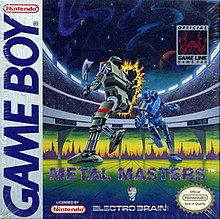Metal Masters
This article relies largely or entirely on a single source. (February 2020) |
| Metal Masters | |
|---|---|
 Game Boy cover art | |
| Developer(s) | Bit Managers (Game Boy) Incal (Amiga) |
| Publisher(s) | Electro Brain (Game Boy) Infogrames (Amiga) |
| Composer(s) | Alberto Jose González |
| Platform(s) | |
| Release | Game Boy
|
| Genre(s) | Fighting |
| Mode(s) | Single-player |
Metal Masters is a 2D fighting video game first released in 1990 for the Nintendo Game Boy and later released in 1991 for the Atari ST, IBM PC, and Amiga.[1]
Plot
The story starts with a villain called the Baron, the Baron is looking for the parts needed to construct the ultimate robot. The player's job is to destroy the robots, thus destroying the parts needed by the Baron.
Gameplay
The player controls a robot, the starting robot is a very basic model, to which the player can add "improvements" with credits earned during gameplay. There are four areas that each robot is graded on, body, left arm, right arm, and legs. There are several different combinations of various parts that can be added to the player's robot for optimum fighting status. During a fight, each area mentioned above is represented by its own health meter. The objective of the player is to deplete the health meters of each area.
Reception
The One reviewed the home computer versions of Metal Masters in 1991, praising the graphics as "impressively animated and colourful", and expresses that Metal Masters is an "unusual" beat 'em up in that it's more enjoyable in two-player mode, furthermore calling it a game "for which a good deal of practice pays off." The One however criticises the 'clanking' sound effects of robots walking as 'grating' and expresses that the game feels too slow, concluding by stating that "Ultimately however, the slight slowness of robot manoeuverability make what could have been a great battle merely a decent one."[1]
References
External links
- Metal Masters (Game Boy version) at GameFAQs
- Metal Masters at Lemon Amiga
- Metal Masters at Atari Mania
